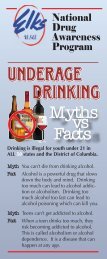Counselor's Manual for Relapse Prevention With Chemically ...
Counselor's Manual for Relapse Prevention With Chemically ...
Counselor's Manual for Relapse Prevention With Chemically ...
You also want an ePaper? Increase the reach of your titles
YUMPU automatically turns print PDFs into web optimized ePapers that Google loves.
Step 3: Identification of Alternatives.What are some options <strong>for</strong> dealing with the problem? Ask the patient to list them on paper sothey can readily see them. Try to have the group come up with a list of at least five possiblesolutions. This will give them more of a chance of choosing the best solution and give themsome alternatives if their first choice doesn't work.Step 4: Projected Consequences of Each Alternative.What are the probable outcomes of each option? Have the group ask the person the followingquestions:What is the best possible thing that could happen if you choose this alternative?What is the worst possible thing that could happen?What is the most likely thing that will happen?What is your reaction (thoughts, feelings, memories, and future projections) when you thinkabout implementing that alternative?Step 5: Decision.Have the group ask the person which option offers the best outcomes and seems to have the bestchance <strong>for</strong> success. Ask them to make a decision based upon the alternatives they have.Step 6: Action.Once they have decided on a solution to the problem, they need to plan how they will carry itout. Making a plan answers the question, "What are you going to do about it?" A plan is a roadmap to achieve a goal. There are long range goals and short range goals. Long range goals areachieved along with short range goals. One step at a time.Step 7: Followup.Ask the person to carry out his or her plan and report on how it is working.Most problems will not be solved by presenting them one time in group session. Personalproblem solving is a process that requires time. It may require three to six presentations of aproblem, accompanied by specific assignments completed between group sessions to bring aproblem to full resolution. Patients should be given a limited time to present a problem or thesummary of an assignment. As a general rule, patients should not work in group <strong>for</strong> more than 20minutes.Not every person will work on a problem during each session. There is an 80/20 rule <strong>for</strong> grouptreatment. Eighty percent of the benefit of group treatment occurs from learning how to becomeresponsibly involved in helping others to solve their problems. Only 20 percent of the benefit isderived from working on personal problem issues.














